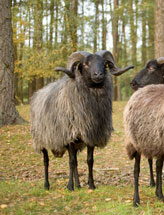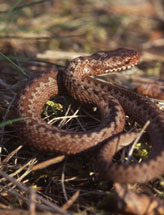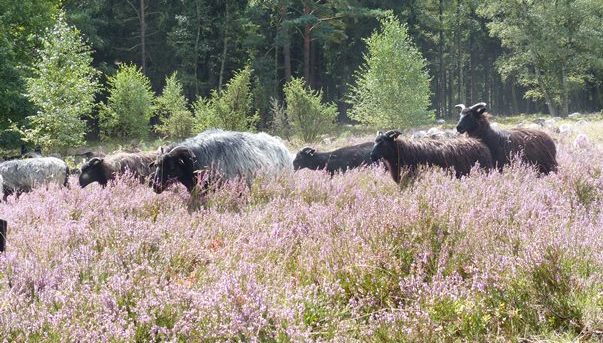Heidschnucke (German grey heath) sheep, wolf, black grouse & co.
The Heidschnucke (German grey heath) is probably the most famous animal on Lüneburg Heath. But the heathland provides a habitat for a variety of rare animals which are on the red list and are threatened with extinction. A small selection of these animals can be found here.
Heidschnucke (German grey heath) sheep - an important landscape conservationist
Extraordinary frugality and robust health are just two of the many positive characteristics of the Heidschnucke (German grey heath) which makes them so likeable. In addition, it has the ability to feed on heather.
The Heidschnuck is presumed to be descended from mouflon originating from Sardinia and Corsica. The rough, grey wool of the German Grey Heath sheep is shorn in May. The sheep’s legs, her tail and head are black. The lambs, which are born in the spring, are born black and change to the parents' colour in the second year. Both sexes have horns. The northern German heathland and moorland landscapes of Lüneburg Heath are the main breeding areas of the Heidschnuck.

The word "Schnucke" in the name of the Heidschnuck comes from schnukerern/schnökern, which means "nibble" or something "sweet".
And another positive feature of the Heidschnuck to mention here is its delicious, game-like meat.
Unfortunately, the present economic situation for Heidschnuck today is not so good because the wool is rarely used today. Income from the sale of the meat is also not sufficient to cover the costs. The owners of Schnucken flocks are therefore dependent on public funding and on donations.
Anyone who would like to support the heathland by helping the Heidschnuck can sponsor a Schnucke at Naturschutzpark e. V.
The Wolf
For some time now, the wolf has been back in Lüneburg Heath Nature Park.
On average, there is a wolf pack of about eight animals, namely the parents, the pups and the immature animals from the previous year (yearlings). Wolf pups stay with their parents until reaching sexual maturity (11 to 24 months). Once this is reached, they leave the parents territory in search of their own. Studies in Saxony and Poland have found that territories vary between 150 and 350 km². In comparison, the city of Hannover is about 204 km² and is thus smaller than the average size of a wolf territory.
Because of regular migration of the sexually mature young and also because of high mortality within the first two years of life, pack size remains relatively constant over the years.
Usually they keep away from people.
You can get information about what to do if you should meet a wolf in this information sheet from the NLWKN (Lower Saxony State Department for Waterway, Coastal and Nature Conservation): Wolf information sheet (German only).
Black grouse
The black grouse has high demands from its habitat. It prefers undisturbed moorland and heathland with birch, spruce and a variety of plants. Only rarely do the existing landscapes meet its needs. Human influences and natural enemies such as the fox or wild boar make life difficult for this game fowl. Therefore, black grouse are very rare in Germany today and are on the red list. However, thanks to the efforts of the Verein Naturschutzpark, the black grouse is still to be found in Lüneburg Heath nature conservation area and on the southern part of the military training area.
Although the black grouse males have beautiful blue-black-coloured plumage, the females are rather more safety conscious. As ground nesting birds they must be well camouflaged and for this reason have simple, brown-black spotted feathers. During the courtship display (the lek), the males ruffle their feathers, jump into the air, strut around and square up to each other.
Nightjar - Once wrongly known as the ‘goatsucker‘
Der Ziegenmelker sonnt sich gerne und genießt häufig ausgiebige Staubbäder. Aktiv ist der Vogel, der im Volksmund auch als Nachtschwalbe bezeichnet wird, aber besonders in der Dämmerung und in der Nacht. Sehen kann man den Ziegenmelker daher nur selten. Durch sein braunschwarzgemustertes Gefieder ist er zudem gut getarnt. Charakteristisch ist sein kurzer Schnabel mit breitem Rachen. Heiden und Moore sind in Europa seine bevorzugten Lebensräume.
Seinen Namen hat der Ziegenmelker Gaius Plinius Secundus, einem römischen Historiker und Schriftsteller, zu verdanken, der den Namen in seiner Enzyklopädie festhielt. Weil sich der Vogel nachts oft in der Nähe des Weideviehs aufhielt, wurde ihm das Melken der Ziegen unterstellt. Dabei interessierte sich dieser nur für die Insekten am Ziegeneuter. Wahrscheinlich haben Menschen, die selbst in der Nacht Durst hatten und die Ziegenmilch getrunken haben, dem auffällig beim Vieh herumfliegenden Vogel später die Schuld in die Schuhe geschoben. Der Ziegenmelker steht in Deutschland auf der Roten Liste.
Adder – a poisonous sunbather who sleeps long in winter
The adder’s optimum temperature for activity is 30 to 33 degrees Celsius. In the winter, therefore, it has to take it easy and finds places to hide with its companions. In March or April, it comes back from hibernation and the mating season begins.
Preferred habitats for the adder are moorland, heathland and damp lowlands. The adder is recognisable by the dark zigzag ribbon on its back. It reaches an average length of 50 to 70 cm. As an ambush predator, the adder attack prey such as frogs and lizards. With its bite it injects poison into the body of the prey, which dies from the poison and is swallowed head first. For humans, however, the adder is usually harmless. It is very shy and moves fast. Ait will only bite if threatened. In Lower Saxony the adder is considered as endangered, nationwide even critically endangered.

Als Lebensräume bevorzugt die Kreuzotter Moore, Heiden und feuchte Niederungen. Die Kreuzotter ist an dem dunklen Zickzack-Band auf dem Rücken zu erkennen. Sie erreicht eine Durchschnittslänge von 50 bis 70 cm. Als Lauerjäger attackiert die Kreuzotter die Beutetiere, zum Beispiel Frösche und Eidechsen. Durch einen Biss injiziert sie Gift in deren Körper. Die Beutetiere sterben an dem Gift und werden mit dem Kopf voran verschlungen. Für den Menschen ist die Kreuzotter jedoch in der Regel ungefährlich. Denn sie ist sehr scheu und flüchtet schnell. Ein Zubiss erfolgt nur bei massiver Bedrohung. Die Kreuzotter gilt in Niedersachsen als gefährdet, bundesweit sogar als stark gefährdet.

![[Translate to Englisch:] Siegel: Europäische Union – Europäischer Fond für regionale Entwicklung.](/fileadmin/_processed_/d/6/csm_europaeische-union-fond-regionale-entwicklung-logo_50eda43563.gif)
![[Translate to Englisch:] Logo Europa für Niedersachsen.](/fileadmin/_processed_/b/e/csm_europa-fuer-niedersachsen-logo_7b3947c73c.gif)
![[Translate to Englisch:] Logo Leader.](/fileadmin/_processed_/c/5/csm_leader-logo_c9a57e9ee0.gif)
![[Translate to Englisch:] Siegel: Europäische Union – Europäischer Landwirtschaftsfond für die Entwicklung des ländlichen Raums.](/fileadmin/_processed_/4/7/csm_europaeischer-landwirtschaftsfond-logo_ce24e54bf4.gif)
![[Translate to Englisch:] Logo touristischer Partner Lüneburger Heide.](/fileadmin/_processed_/4/3/csm_lueneburgerheide_positiv-mit-schatten_logo_00411b91a8.gif)